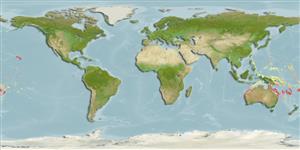>
Argentiniformes (Marine smelts) >
Argentinidae (Argentines or herring smelts)
Etymology: Glossanodon: Greek, glossa = tongue + Greek, anodos = without teeth (Ref. 45335).
Eponymy: Dr Paul James Struhsaker (1935–2018) was a fishery biologist and ichthyologist. [...] (Ref. 128868), visit book page.
More on author: Cohen.
Environment: milieu / climate zone / depth range / distribution range
Ökologie
seewasser benthopelagisch; tiefenbereich 185 - 373 m (Ref. 58302). Temperate; 23°N - 30°S, 112°E - 153°W
Western Central Pacific: Australia (Ref. 7300). Eastern Pacific: Hawaiian area (Ref. 583).
Size / Gewicht / Alter
Maturity: Lm ? range ? - ? cm
Max length : 11.0 cm SL Männchen/unbestimmt; (Ref. 31667)
Occurs on the outer shelf and upper slope, rarely to 1400 m.
Life cycle and mating behavior
Geschlechtsreife | Fortpflanzung | Ablaichen | Eier | Fecundity | Larven
Paxton, J.R. and D.M. Cohen, 1999. Argentinidae. p. 1884. In K.E. Carpenter and V.H. Niem (eds.) FAO species identification guide for fishery purposes. The living marine resources of the WCP. Vol. 3. Batoid fishes, chimaeras and bony fishes part 1 (Elopidae to Linophrynidae). FAO, Rome. (Ref. 9857)
IUCN Rote Liste Status (Ref. 130435: Version 2024-2)
Bedrohung für Menschen
Harmless
Nutzung durch Menschen
Fischereien: nicht kommerziell
Tools
Zusatzinformationen
Download XML
Internet Quellen
Estimates based on models
Preferred temperature (Ref.
123201): 17.8 - 21.2, mean 18.9 °C (based on 16 cells).
Phylogenetic diversity index (Ref.
82804): PD
50 = 0.5001 [Uniqueness, from 0.5 = low to 2.0 = high].
Bayesian length-weight: a=0.00363 (0.00163 - 0.00807), b=3.17 (2.98 - 3.36), in cm total length, based on LWR estimates for this (Sub)family-body shape (Ref.
93245).
Trophic level (Ref.
69278): 3.1 ±0.3 se; based on size and trophs of closest relatives
Widerstandsfähigkeit (Ref.
120179): hoch, Verdopplung der Population dauert weniger als 15 Monate. (Preliminary K or Fecundity.).
Fishing Vulnerability (Ref.
59153): Low vulnerability (10 of 100).
